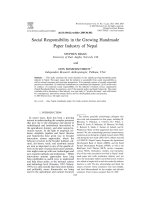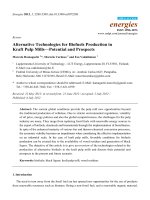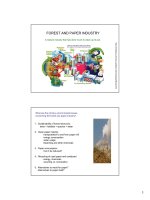Environmental Challenges – Pulp & Paper Industry Caroline Gaudreault pdf
Bạn đang xem bản rút gọn của tài liệu. Xem và tải ngay bản đầy đủ của tài liệu tại đây (655.62 KB, 125 trang )
Program for North American Mobility in Higher
Education
Introducing Process Integration for Environmental
Control in Engineering Curricula
Module 4: Environmental Challenges –
Pulp & Paper Industry
Caroline Gaudreault
Created at:
École Polytechnique de Montréal &
Texas A&M University, 2003
LEGEND
Go to the web site
Go to next subject
More information on the same subject
Look for the answer to the question
2
Tier II:
Case Study Applications
Tier II: Statement of Intent
Tier II: Statement of Intent
The purpose of this module is to demonstrate
the application of the minimum manufacturing
concepts using the Thunder Bay and LouisianaPacific case studies, and introduces the
concepts of BAT and strategic planning.
Tier II also includes some selected readings, to
help the student acquire a deeper
understanding of this subject.
4
Tier II: Content
Tier II is broken into four sections:
2.1 The Thunder Bay case study
2.2 The Louisiana Pacific Samoa case study
2.3 Strategic long-term planning for kraft mills,
technology roadmaps, and MIM metrics
2.4 Best Available Technologies for the kraft
processes
At the end of Tier II, there is a short multipleanswer quiz
5
2.1 REVIEW OF THE CLOSE-CYCLE
OPERATING EXPERIENCE at
GREAT LAKES FOREST
PRODUCT LIMITED
(Thunder Bay Mill)
A Little Bit of History
In 1974, Great Lakes Forest Products Limited (GLFP)
decided to build a second kraft line (kraft mill B) in their
mill located in Thunder Bay, Ontario. As a result of this,
the Ontario Ministry of the Environment (OMOE) asked
them to construct a secondary treatment of the effluent in
order to reduce BOD5, toxic elements and suspended
solids discharged to the river. GLFP considered aerated
lagoons but there was no close available space to
accommodate it. This is why they began to discussed
with Howard Rapson
at the University of Toronto
about the “Closed-Cycle Mill” concept. They endorsed
the concept and submitted the project to the OMOE in
place of secondary treatment.
7
A Little Bit of History (Cont’d)
The OMOE gave the approval for the construction of the “closecycle” kraft mill B, but with the provision than by March 1978, GLFP
proves that:
The system to be operational;
To be as efficient as secondary treatment and,
Following this, GLFP propose to install the “close-cycle” system to
the other kraft line (kraft mill A).
The B mill began its operations in 1976 but the “close-cycle”
operations were initiated only in 1977 after the salt recovery plant
was completed.
From 1977 to 1985, the “close-cycle” system was developed
continuously in collaboration with the University of Toronto as well
than with other players.
8
A Little Bit of History (Cont’d)
Pitch deposits and scaling problems severely limited
close-cycle operations, and more particulary during
hardwood processing.
In 1985, the close-cycle operations were discontinued
for a lot of reasons including:
It was possible to obtain an equivalent BOD5 reduction only
by increasing evaporator condensate use and recovery;
Operating costs were high. These costs include increased
bleaching chemical costs and high energy costs for the salt
recovery plant;
Heat exchangers in the salt recovery plant were corroded
and it would have been very expensive to replace/upgrade
them.
9
Information about Kraft Mill B
Bleached pulp production of 250 000
ton/year
First Canadian “effluent-free” pulp and
paper mill
World’s first application of the RapsonReeve closed cycle concept
10
Bleach Plant Description
A blend of spruce and jackpine chips was fed Kamyr
continuous digester.
The pulp was washed in a two-stage washer.
The bleach plant consist in 5 stages D CEDED:
D C: use of chlorine dioxide and elementary chlorine
sequentially in the same stage, using ClO2 in large quantity
prior to chlorine in the first stage will allow for an overall
bleach chemical reduction, an increased yield and a
preserved pulp resistance;
E: alkaline extraction (dissolution of reaction product with
NaOH);
D: chlorine dioxide (reaction with ClO2 in acidic medium)
Whitewater is used to wash the pulp counter-currently.
11
Salt Recovery Process Description
Clarified white liquor from the recausticizing
department was concentrated in an evaporator to
increase the alkali content.
Precipitated sodium carbonate and burkeite
(2Na2SO4.NACO3) were removed by clarification and
cyclone separation system.
The clarified concentrated liquor was reconcentrated
in an other evaporator to recover more
2Na2SO4.NACO3.
The recovered salt was treated with sodium
hypochlorite to oxidize organic impurities.
Finally, after a sand filtration, the salt was used in the
chlorine dioxide generators.
12
Key Features of the “Close-Cycle”
System installed in Great Lakes Mill
The main characteristics of the system were:
13
Dry drum debarkers;
Pressure (closed) primary knotters and screens;
Use of pulp dryer vacuum pump seal water in the wet end of the dryer
and use of excess white water on the final D stage bleach plant
washer;
Full countercurrent washing in the bleach plant;
A new salt removal process (SRP) based on evaporation of the white
liquor in two stages to produce crystalline sodium chloride;
Use of excess filtrate from the E1 washer to dilute concentrated white
liquor and to wash the unbleached pulp;
Use of excess D C filtrate after neutralization with caustic or white
liquor for brown pulp washing and in the lime kiln scrubber, and
subsequently for smelt dissolving;
70% chlorine dioxide substitution for chlorine in the first stage to
minimize chloride load to the recovery system;
An extensive spill collection and recovery system;
A stripping column to clean the foul condensates.
Overview of Water Recovery
Water
DC Filtrate
ClO2 Solution
Bleach Plant
E1 Filtrate
Brownstock Washers
Digesters
Evaporators
Recovery Furnace
Concentrated
White Liquor
Smelt Dissolver
White Liquor
Causticizer
SRP Process
14
Condensate
Salt
(Adapted from Springer & al., 2001)
Expected Benefits from the
Close-Cycle Mill
Lower steam consumption
Greater steam production
Decrease of 1% fiber losses from screening,
washing, etc.
Increase of 1% in bleached pulp mill
Lower consumption of bleach chemicals, and
reduced salt cake and defoamer use
Elimination of external waste treatment
Reduction in kraft mill odor
Substantial annual operating cost savings
15
Impact on Pulp Mill Operations
The Bleach Plant
Corrosion:
High temperature and chloride levels
will increase the potential for corrosion
in the close-cycle system. Even in
bleaching plant equipment building
material was carefully selected. Early
evidence of corrosion was noted.
16
Deposits:
Hardwood runs were characterized by
deposits from wood extractives,
residues from defoamers and other
sources which caused a lot of
problems: pitch, scale, defoamer
residues and talc/pitch deposits
plugged washer fabrics and wires,
washer nozzles and filtrate lines.
Because of that, some filtrate recycle
streams were discontinued during
hardwood runs.
Initial Design Problems:
A bad design of some of the bleaching
tanks occasioned brightness problems
and an increase in bleaching chemical
consumption.
Air separation devices for the washers
was not well conceived. This caused
foaming problem during the washing
stages.
The generation capacity of ClO2 was
insufficient to meet the target of 70%
substitution in the chlorination stage.
The substitution averaged 50%. The
capacity was increased.
There was no purge stream in the
system.
This resulted in an
accumulation of Ca and so, in severe
scaling problems.
Etc….
Impact on Pulp Mill Operations
The Bleach Plant
D
C Closure:
Prior to be recycled, the
filtrate from this stage was
neutralized with NaOH which
result in a Ca/lignin/pitch
precipitation that deposited
on fabric and wire and in a
impaired drainage.
These
deposit were removed using
acid which result in corrosion.
Also, because of the high
organic content in the recycle
stream,
there
was
an
increase
in
chemical
consumption for this stage.
17
E1 Closure:
E1 filtrate was recycled to the
brown decker which resulted
in poor washing efficiency and
carryover to the D
C stage
with
incresed
chemical
consumption.
This
was
corrected
by
recycling the E1 filtrate to
washer where the solids
content matched more the
dissolved solids in the filtrate.
Availability of the SRP,
pluggage, pitch and scale had
also severely hampered E1
closure.
Impact on Pulp Mill Operations
Monitoring and Control
Maintaining water balances was difficult
during startups, shutdowns, upsets and
disturbances.
Because of they were upsetting the
water balances, spill recovery was not
very successful.
18
Impact on Pulp Mill Operations
The Digester
No noticeable effect on the digester
operations.
19
Impact on Pulp Mill Operations
The Black Liquor Evaporators
Advanced corrosion in the black liquor
evaporators reduced their life-time from
25 to 5 years.
The pulp mill operations were restricted
due to a limited evaporator capacity.
The later was increased but the spills
were never effectively recclaimed.
50% of total BOD5 of the kraft mill B
was attributable to the evaporators
condensate.
20
Impact on Pulp Mill Operations
Recovery Boiler
Recovery boiler corrosion caused
significant production losses and other
costs.
21
Impact on Pulp Mill Operations
Recausticizing and Lime Kilnb
Neutralized D
C filtrate was used in the lime kiln
scrubber. The filtrate ended up in the weak wash,
green liquor, and white liquor.
The filtrate hampered dregs settling in the green
liquor clarifier and lime mud settling in the white liquor
clarifier.
A high dust loading reduced the kiln capacity by 10 to
15%.
The organic content of the filtrate had as
consequence to form a yellow unreactive lime with
variable slaking efficiency. Because of this higher
temperatures were needed which result in higher fuel
costs.
22
Impact on Pulp Mill Operations
The Salt Recovery Plant
Corrosion:
Salt-falls
in
the
evaporators
caused
corrosion.
Some pitting corrosion
occurred on the vapor
side of the crystallizer
heat exchanger.
Design:
The SRP experienced
poor steam econokmy
and high energy costs.
23
Low Availability:
The
original
liquor
solids removal system
(thickeners and vacuum
filters)
were
not
effective in handling
large
crystal
size
distributions.
It was
replaced by a cyclone.
Heater Fouling:
Scale occurred in the
evaporators
that
needed
frequent
washes.
Obstacles to Increased Mill Closure
1.
SRP reliability
It was poor.
After equipment and process modification the
availability was adequate for 50% closure if the pulp mill uses 50%
hardwood and 50% softwood.
2.
Water balance problems
The problems occurred during startups and shutdowns and there
were problems recovering excess filtrates generated during upsets.
3.
4.
Equipment and process restrictions
During the SRP shutdowns, there was no capacity to store and
recover E1 filtrate used to dilute the SRP white liquor.
Pitch problems
These occurred particularly with hardwood pulping and bleaching.
5.
Recovery boiler corrosion
Chloride input to the recovery cycle was restricted to reduce the
potential for more corrosion.
24
Sucesses and Benefits
Change in the operating philosophy to one minimizing water
inputs and controlling effluent discharges.
Low volume of effluent discharged from the bleach plant.
Some successful recycle of bleach plant filtrates to the chemical
recovery.
Successful salt removal from the white liquor.
Use of removed salt in the chlorine dioxide generators.
High chlorine dioxide substitution
pulp with not detectable
levels of dioxines and furans.
Development of techniques to minimize impact of wood
extractives.
During they operate in close-cycle, they assess secondary
treatment for all their operations. They finally installed an
oxygen activated sludge treatment instead of an aerated lagoon.
25









